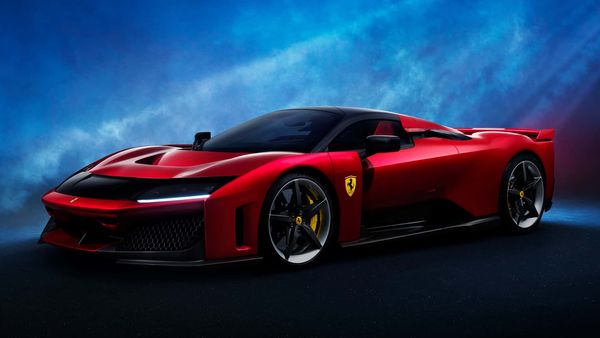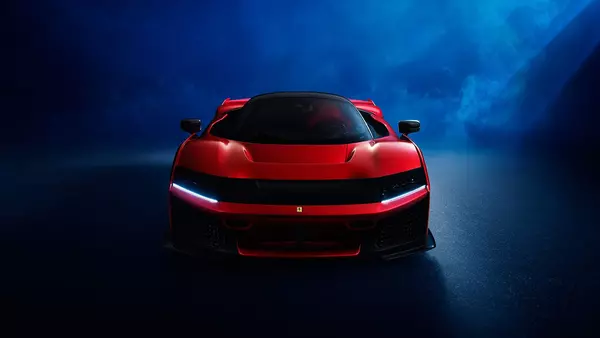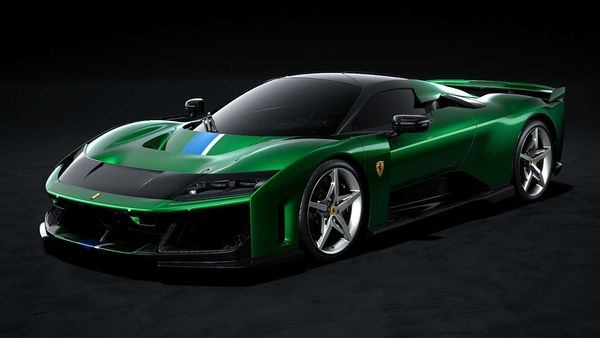
Active suspension was long a dream of vehicle dynamics engineers, and last year with the Ferrari Purosangue, it finally became a production-car reality. Porsche soon followed up with an active-suspension system for the Panamera and Taycan. But with Ferrari’s new hypercar, the world will finally see the full capability of this remarkable tech.
First off, a primer on active suspension. Essentially, it’s any system that can put force into a car’s suspension independent of external inputs. Note that this is not an adaptive system, which might have features like adjustable ride height or adjustable dampers. Those systems are simply reactive, and can only respond to inputs from the road surface below or the driver; an active suspension can put force into the suspension independent of these influences.
The Ferrari system is based on hardware developed by Canadian supplier Multimatic, True Active Spool Valve (TASV) dampers. These dampers have a 48-volt motor geared to a ball screw that controls the motion of the piston. Each motor can apply 5 kilonewtons (1,120 pounds) of force into a damper almost instantaneously. This allows for the use of relatively soft springs, and eliminates the need for anti-roll bars, with the dampers solely responsible for controlling body motions. Effectively, you have a suspension system where each wheel is fully independent of one another, and one where you can totally decouple ride and handling characteristics from one side of the vehicle to the other.
(Porsche Active Ride is similar in application, but instead of using motors and ball screws, it uses hydraulic pumps to vary fluid level in each damper.)
A system like this allows for all sorts of incredible possibilities. For example, the system can optimize the load on each tire independently through all phases of a corner, managing the center of aerodynamic pressure the whole way. And that’s why it’s exciting to see it on the Ferrari F80. This is a car that will be able to fully exploit all that active suspension offers.
This isn’t to denigrate any of the other three active-suspension production cars we’ve seen thus far. All three are hugely impressive, but each is a heavy four-door that uses active suspension to allow for a wide spread between ride quality and performance capability. The Taycan Turbo GT is the most overtly track-oriented car on sale to use active suspension, but even that is a 4,925-pound sedan.
The F80 is not the lightest thing in the world—Ferrari quotes a dry weight of 3,362 pounds, and note that a “dry” weight is taken without any of the fluids necessary for driving. So realistically, this is a 3,500-pound car. But it is a true hypercar with 1,200 horsepower from its hybrid, all-wheel drive, mid-engine V-6 drivetrain, plus huge levels of downforce. Two-thousand twenty-four pounds at 155 mph. That’s as much downforce as any road car short of the Aston Martin Valkyrie, which makes 2,425 pounds at 137 mph. Or, I suppose, a McMurtry Spéirling if you can consider that a real road car. The F80’s downforce is comparable to the figures generated by a GT3 race car.
With big aero loads like this, it is critical to keep the car’s so-called “platform” stable. Downforce, especially that which is generated underneath the car with diffusers, is very sensitive to ride height. The lower the car gets, the more downforce you get, but there is a point where the downforce you generate can bottom out the car’s suspension, creating a stall in the airflow which bounces the car back up again in a vicious cycle. If you’re an F1 fan, you might recognize this as the “porpoising” we saw when the current ground-effect aero regulations were introduced in 2022.


Essentially, you want to keep the car as flat and as level as possible without bottoming out. Typically you do this with ultra stiff springs and anti-roll bars, and that’s fine to a large degree in a race car, but for a road car, it’s hardly ideal. With active suspension, you could go so far as to hold the car perfectly level on track, but then use the dampers to have real compliance on the road.
I doubt Ferrari will cancel out all body motions, though. When driving the Purosangue, there is body roll, pitch, and dive, so the driver has some sense of what the car is doing. A car that’s body doesn’t move at all feels very strange. I imagine that in the F80, Ferrari will allow for some body motions on the street while severely tamping down, if not totally eliminating them, on track.
The biggest downsides to TASV dampers are cost and weight. Cost is basically irrelevant on a car like this, but the dampers need 48 volt power and their own cooling circuit. A setup like this is heavier than conventional suspension, but clearly Ferrari thinks the tradeoff is worthwhile. It’s hard not to agree. Active suspension allows for unprecedented control of vehicle dynamics. And, Ferrari is able to design the whole vehicle around the fact that it doesn’t need any anti-roll bars connecting the left and right sides of the car. So an apples-to-apples comparison between active and conventional suspension isn’t possible here.

In Formula 1 with the Williams FW14B, active suspension proved devastatingly effective. During the 1992 F1 season, Nigel Mansell either finished 1st or 2nd in all but four races. Those four? All retirements. The 1993 Williams FW15C was similarly dominant, and for 1994, F1 banned electronic driver aids. To this day, active suspension is still banned.
There is nothing more effective for getting the most out of a car with huge power, huge downforce, and huge mechanical grip. And it also ensures that the F80 will be comfortable as a street car.
I don’t expect this suspension system will get many headlines beyond this in the coverage of the F80. Yet, this seems to be a key ingredient for the car, the thing that should make the F80 unbelievably fast yet still usable on the road.











